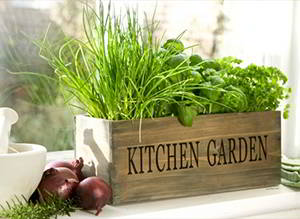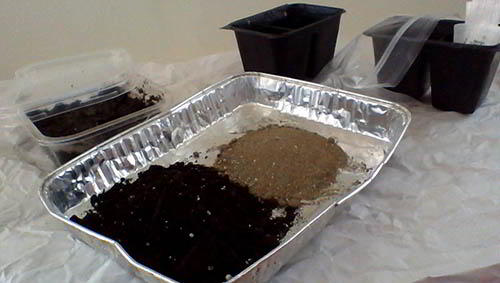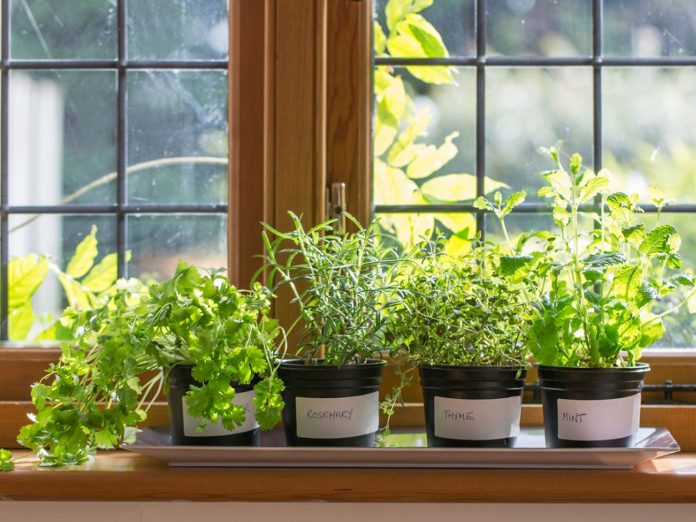For every survivalist, fresh herbs should be a priority. They are perfect for flavoring foods, but they are also packed with vitamins and some are used for medicinal purposes. Herbs grow like weeds outdoors to sandy garden soil on average, but conditions may not always be conducive to growing outdoors. Animals could eat them, other people might help themselves or you might just like the convenience of having them indoors. So long as you can give enough light, it’s easy to grow herbs indoors. You can buy seedlings or start them from seed.
What you will need:

- Seed-starting container (flats, pots or even re-purposed plastic containers)
- Houseplant potting soil (average garden soil does not drain quickly enough for container plants)
- Coarse builder’s sand or vermiculite
- Herb seeds
- Pots with drain holes in the bottom
- Fluorescent lights for low-light conditions
- 24-hour plug-in timer
How to start seeds:
- Prepare the container. Soak used containers in disinfectant for 10 minutes after washing them with hot, soapy water. Soak new, porous terracotta or clay pots in fresh, clean water for 6 to 8 hours so that they don’t suck the moisture out of the seed-starting mix.
- Mix course builder’s sand or vermiculite with a half-and-half mixture of houseplant potting soil.
- Pour the mixture starting from seed into the container. It should be roughly 2 inches deep.
- Mix with water to moisten. Use distilled water or tap water that has been aged for 24 hours in an open container.
- Sow the seeds 2 to 4 inches apart in the mixture before moistening. Depth of planting varies according to herb. Most should be protected by no more than 1/4 inch mixture.

- Put the container in a zipper-close, clear plastic bag and seal it shut or seal the container with a lid. Use a clear lid so you can easily see the new sprouts. Set the container in bright, indirect light.
- Check the mix daily. Spray it with aged or distilled water from a spray bottle if it begins to dry. The seeds must be kept moist and warm. About 75 degrees F. or 24 degrees C. is best.
- Remove the cover as soon as you see the little green sprouts emerging. Set the container where they will get 1 to 2 hours of direct sunlight after the sprouts are about 1/2 inch tall.
- Continue to keep them moist and warm.
Related: Having Debilitating Migraines? Read This!
How to Care for Herbs Indoors:
The biggest challenge that you will face when you grow herbs indoors will be providing enough light. Outdoor light is significantly brighter than indoor light. Windows facing south will give plenty of light to herbs and with a western exposure they could do fine. Windows facing east will not provide enough natural sunlight and windows facing north will of course not provide any direct sunlight. In an eastern or northern exposure, herbs will have to get additional light. Otherwise, if at all, they’ll grow slowly and become pale and spindly. If you only have an eastern or northern opening, though, there’s no need for concern. As long as you have full spectrum fluorescent lights and electricity, you can give the light it needs to your herbs.
- Pot up the new herb seedlings as soon as they are big enough to handle or when they are 2 to 4 inches tall. Each herb should have a 4- to 6-inch diameter pot or you can put multiple plants in larger containers.
- Pour 1 to 2 inches of houseplant potting soil into containers with drain holes. Most herbs grow best in a mix consisting of 2/3 to 3/4 potting soil and 1/3 to 1/4 vermiculite or coarse builder’s sand.
- Gently work the seedlings up out of the seed-starting mix. Use a small spoon or butter knife to push them up out of the soil. Handle them gently by the rootball. Do not try to pick them up by the stem.
- Set each seedling in its new container and gently hold the stem upright while you fill in around the roots with more potting soil.
- Water newly planted herbs until the water drains from the drain hole in the bottom of the pot. Water carefully, though, so you don’t wash the plant right up out of the soil.
- Set the newly-potted herbs where they will get 1 to 2 hours of direct sunlight. Increase the direct sunlight exposure by 1 to 2 hours every few days to gradually get them used to at least 6 hours of direct sunlight.
In an eastern or northern window, if you grow herbs, place fluorescent lights so that they are 4 to 6 inches above the plants. Using a reflector hood 2- to 4- bulb fixture. You can use 1 to 2 full-spectrum plant bulbs, and 1 to 2 20- to 40-watt cool-white bulbs. The cheaper white bulbs are good. Make sure the lamp fixture is adjustable, so that as the herbs grow, you can raise the bulbs.
Plug in a 24-hour timer with the fluorescent light fixture. Set the timer to turn the sunrise lights on. The lights will be as follows:
- 12 to 14 hours for plants in an east-facing window.
- 16 to 18 hours for plants in a north-facing window.
Monitor herbs which grow in front of a window facing the west. When they start to grow gradually or become gray and spindly, set fluorescent lights and set the timer, so they remain on every day for 12 to 14 hours.
Note, natural light is replaced by the fluorescent bulb. Keeping the day/night cycle is critical, so that the herbs get 8 to 10 hours of dark at night. Newly-potted seedlings can be placed immediately under the fluorescent lights but start with the lights hanging 8 to 10 inches above them, so they are not overwhelmed.

Related: This Common Driveway Weed is One of Nature’s Most Powerful Survival Plants
Water and Fertilizer
Rule of thumb is – water when the top inch of potting soil gets dry. Some herbs like their soil, however, are kept moist while others prefer dryer conditions. For starters, rosemary, oregano, and parsley grow best when the potting soil remains uniformly moist. When the top of the potting soil just starts drying, water them. Basil, on the other hand, grows best if a bit of dryer is stored. Before watering basil, you may let the top 1 to 2 inches of potting soil become dry. Pour the water equally over the soil until the bottom of the pot begins to drain.
If you are using tap water, use water that has been “aged” or left in an open container for 24 hours. That allows dissipation of the chlorine. You can also use rain water or distilled water, and should do so if sodium is high in your tap water. Plenty of water purification systems can induce high levels of sodium in the tap water. It may be enough merely to might the sodium levels by combining tap with purified or rain water. If a white residue forms into the potting soil, sodium levels are too high. To extract the excess sodium, either re-pot the herbs in fresh potting soil or drill the current soil with rain or distilled water.
Feed herbs diluted to half force with fertilizer. For most herbs, a balanced fertilizer ratio of 10-10-10 is fine, though some, including basil, prefer a high-nitrogen fertilizer. High-nitrogen fertilizer should have a higher number first mentioned in the list of ratios. For example, a fertilizer with a 10-3-3 ratio is a fertilizer high in nitrogen.
Give the fertilizer herbs to water every third or fourth. Still give them fertilizer immediately upon daily watering. Never give fertilizer to herbs before rinsing them.











